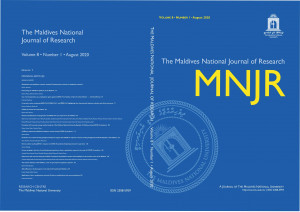Potential Synergies Between The United Nations Sustainable Development Goals And The Value Loading Problem In Artificial Intel-ligence
DOI:
https://doi.org/10.62338/5kbmme28Keywords:
Artificial intelligence value-loading problem, United Nations Sustainable Development Goals, artificial intelligence safetyAbstract
The objective of this article is to identify synergies for two relevant challenges, which are currently faced by the world community, yet addressed separately: The artificial intelligence value-loading problem and the United Nations Sustainable Development Goals. First, the challenges and their significance are outlined. Subsequently, opportunities and risks are discussed to utilize the Sustainable Development Goals to set the values of an artificial intelligence. History has shown that it is complex to agree on universal and sufficiently specific human goals. Nevertheless, this is a prerequisite to approach the artificial intelligence value-loading problem, which is closely linked to artificial intelligence safety. So far, it has not been considered harnessing the Sustainable Development Goals in this context. Yet, the Sustainable Development Goals can be seen as the closest and most comprehensive existing approximation towards common human goals since it is what the United Nations, i.e. the world community, currently agrees upon. Such an attempt entails various risks, which are discussed and which are anticipated given that the artificial intelligence value-loading problem is considered very hard. However, due to the urgency it is argued here that the Sustainable Development Goals constitute an innovative as well as promising interim heuristic towards artificial intelligence safety
References
Asilomar AI Principles (2017).Retrieved from: https://futureoflife.org/ai-principles/Bostrom, N. (2014a). Superintelligence: Paths, Dangers, Strategies. Oxford: Oxford University Press.
Bostrom, N. (2014b). Hail Mary, value porosity, and utility diversification. Technical report, Oxford University.
Retrieved from: https://nickbostrom.com/papers/porosity.pdfEden, A.H., Moor, J.H., Søraker, J.H., & Steinhart, E. (Eds.)(2013). Singularity Hypotheses: A Scientific and Philosophical Assessment. Heidelberg, New York, Dordrecht, London: Springer.
Franklin, S. (2014). History, motivations, and core themes. In Frankish, K., & Ramsey, W. M. (Eds.). The Cambridge handbook of artificial intelligence, 15-33. Cambridge: Cambridge University Press.
Inter-agency and Expert Group on SDG Indicators (2018, May 11). Tier Classification for Global SDG Indicators.
Retrieved from: https://unstats.un.org/sdgs/files/Tier%20Classification%20of%20SDG%20Indicators_11%20May%202018_web.pdf
International Council for Science and International Social Science Council (2015). Review of Targets for the Sustainable Development Goals: The Science Perspective. Paris: International Council for Science (ICSU).
Retrieved from: www.icsu.org/publications/reports-and-reviews/review-of-targets-for-the-sustainable-development-goals-the-science-perspective-2015/SDG-Report.pdf
Kurzweil, R. (2005). The Singularity Is Near. New York: Viking.Legg, S., & Hutter, M. (2007). Universal intelligence: A definition of machine intelligence. Minds and Machines, 17(4).
Retrieved from: https://arxiv.org/pdf/0712.3329.pdfMacAskill, W. (2016, October 7). Moral Progress and Cause X.Retrieved from: https://www.effectivealtruism.org/articles/moral-progress-and-cause-x/
Maderer, J. (2016). Artificial Intelligence Course Creates AI Teaching Assistant. Georgia Tech News Center, 9.
Retrieved from: http://www.news.gatech.edu/2016/05/09/artificial-intelligence-course-creates-ai-teaching-assistant
Mnih, V., Kavukcuoglu, K., Silver, D., Rusu, A. A., Veness, J., Bellemare, M. G., Graves, A., Riedmiller, M., Fidjeland, A. K., Ostrovski, G., Petersen, S., Beattie, C., Sadik, A., Antonoglou, I., King, H., Kumaran, D., Wierstra, D., Legg, S., & Hassabis, D. (2015). Human-level control through deep reinforcement learning. Nature, 518(7540), 529-533.
Retrieved from:https://www.nature.com/nature/journal/v518/n7540/full/nature14236.htmlOmohundro, S. M. (2008). The basic AI drives. AGI (Vol. 171), 483-492.Retrieved from: https://pdfs.semanticscholar.org/a658/2abc47397d96888108ea308c0168d94a230d.pdf
Shademan, A., Decker, R. S., Opfermann, J. D., Leonard, S., Krieger, A., & Kim, P. C. (2016). Supervised autonomous robotic soft tissue surgery. Science translational medicine, 8(337), 337ra64-337ra64
Soares, N. (2016). The Value Learning Problem. Proceedings of the Ethics for Artificial Intelligence Workshop at 25th International Joint Conference on Artificial Intelligence (IJCAI-2016).
Retrieved from: https://intelligence.org/files/ValueLearningProblem.pdfSustainable development goals - 17 Goals to Transform Our World (2018, July 12).Retrieved from: https://www.un.org/sustainabledevelopment/Sustainable development knowledge platform (2018, July 12).
Retrieved from: https://sustainabledevelopment.un.org/Tegmark, M. (2017). Life 3.0: Being Human in the Age of Artificial Intelligence. New York: Knopf
United Nations, General Assembly (2015). Transforming our world: the 2030 Agenda for Sustainable Development. Resolution A/RES/70/1.
Retrieved from: http://www.un.org/en/ga/search/view_doc.asp?symbol=A/RES/70/1
United Nations, General Assembly (2017). Work of the Statistical Commission pertaining to the 2030 Agenda for Sustainable Development. Resolution A/RES/71/313.
Retrieved from: http://www.un.org/en/ga/search/view_doc.asp?symbol=A/RES/71/313
Yampolskiy, R.V. (2015). Artificial Superintelligence: a Futuristic Approach. Chapman and Hall/CRC Press (Taylor & Francis Group).
Yudkowsky, E. (2008). Artificial Intelligence as a Positive and Negative Factor in Global Risk. In Bostrom, N., & ćirković, M. (Eds.). Global Catastrophic Risks, 308–345. Oxford: Oxford University Press.
Retrieved from: https://intelligence.org/files/AIPosNegFactor.pdfYudkowsky, E. (2015, May 24). Complexity of value [Blog post].Retrieved from: https://arbital.com/p/complexity_of_value/
Ziesche, S. (2017). Innovative Big Data Approaches for Capturing and Analyzing Data to Monitor and Achieve the SDGs. Report of the United Nations Economic and Social Commission for Asia and the Pacific: Subregional Office for East and North-East Asia (ESCAP-ENEA).
Retrieved from: http://www.unescap.org/sites/default/files/publications/Innovative%20Big%20Data%20Approaches%20for%20Capturing%20and%20Analyzing%20Data%20to%20Monitor%20and%20Achieve%20the%20SDGs.pdfS. Ziesche



